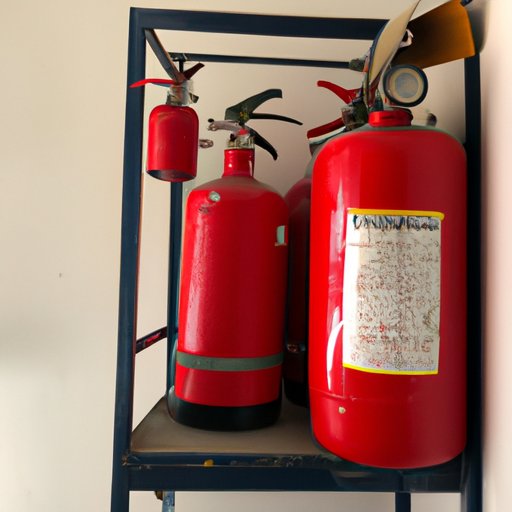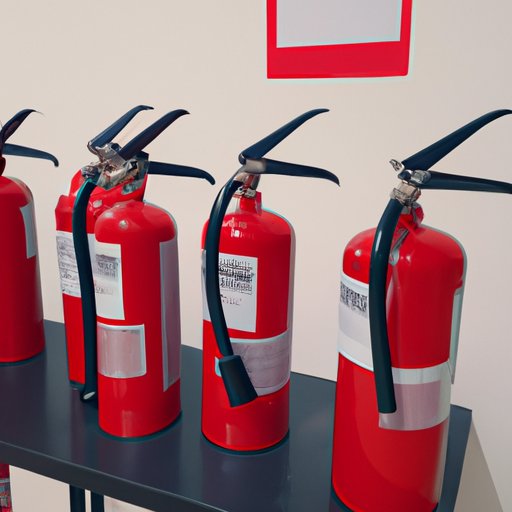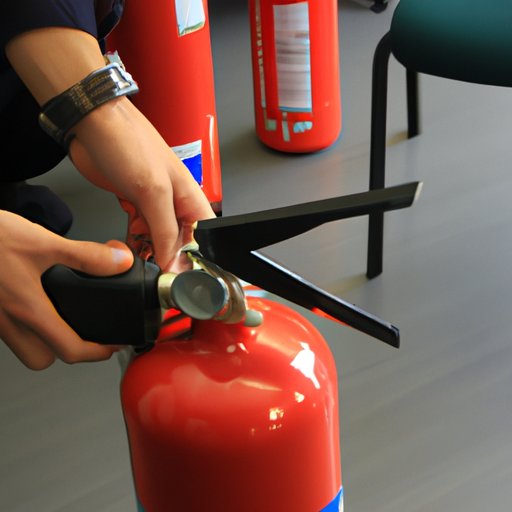Introduction
A fire extinguisher is an active fire protection device used to extinguish or control small fires, often in emergency situations. It is not intended for use on an out-of-control fire, such as one which has reached the ceiling, endangers the user (i.e., no escape route, smoke, explosion hazard, etc.), or otherwise requires the expertise of a fire brigade.
The purpose of this article is to provide an overview of how fire extinguishers work, the science behind them, different types of extinguishers, and how they are used. We’ll also discuss the components of a fire extinguisher, proper maintenance procedures, and important safety tips.
Step-by-Step Guide to How Fire Extinguishers Work
To understand how fire extinguishers work, we must first look at the process involved. This can be broken down into two main steps:
- Dispersing the agent
- Cooling the fuel
Overview of the Process
When the fire extinguisher is activated, the pressurized agent is released from the nozzle. The agent coats the fuel, cutting off the fire’s access to oxygen. This interrupts the chain reaction that feeds the fire, and eventually puts it out.
In addition to smothering the fire, the agent also helps to cool the fuel. This helps to prevent reignition and further spread of the fire.
Detailed Steps Involved
To better understand the process of how fire extinguishers work, let’s break down the individual steps involved.
The first step is to activate the fire extinguisher. Depending on the type of fire extinguisher, this can be done by squeezing a lever, pressing a button, or pulling a pin. This releases the pressurized agent from the nozzle.
Next, the agent is dispersed over the fuel. This coats the fuel, preventing it from receiving oxygen. Without oxygen, the chain reaction that feeds the fire is interrupted, and the fire is extinguished.
The agent also helps to cool the fuel, reducing the risk of reignition and further spread of the fire.

The Science Behind Fire Extinguishers
Now that we’ve looked at the process of how fire extinguishers work, let’s take a closer look at the science behind them.
Chemical Reactions and Heat Transfer
The primary mechanism of how fire extinguishers work is based on chemical reactions and heat transfer.
When the agent is released from the nozzle, it reacts with the fuel to produce a gas. This gas absorbs heat from the fuel, cooling it and reducing its combustibility.
The agent also displaces oxygen, which further reduces the combustibility of the fuel. This interrupts the chain reaction that feeds the fire, and eventually puts it out.
What Fire Extinguishers Do
In summary, fire extinguishers work by interrupting the chain reaction that feeds the fire. This is accomplished by cooling the fuel and displacing oxygen.

Exploring the Different Types of Fire Extinguishers
Fire extinguishers come in many different shapes and sizes, and are designed for specific types of fires. Let’s take a look at the different classifications and types of agents.
Comparing Classifications
Fire extinguishers are classified according to the type of fire they are designed to extinguish. The most common classifications are A, B, C, and D.
- Class A – Ordinary combustible materials such as wood, paper, cloth, and plastics
- Class B – Flammable liquids such as gasoline, oil, grease, and paint
- Class C – Electrical equipment such as appliances, wires, and circuits
- Class D – Combustible metals such as magnesium, titanium, sodium, and potassium
Types of Agents
Fire extinguishers also come with different types of agents. The most common agents are water, foam, dry powder, and carbon dioxide.
- Water – Used for Class A fires
- Foam – Used for Class B and A fires
- Dry Powder – Used for Class B, C, and A fires
- Carbon Dioxide – Used for Class B and C fires
A Comprehensive Look at How Fire Extinguishers Are Used
Now that we’ve explored the different types of fire extinguishers, let’s take a look at how they are used.
Identifying Different Fires
It is important to identify the type of fire before using a fire extinguisher. This will help you determine which type of extinguisher to use, and how to use it.
When to Use a Fire Extinguisher
Once you have identified the type of fire, you can decide if it is safe to use a fire extinguisher. If the fire is spreading quickly, or if it is too large to be controlled, it is best to evacuate the area and call the fire department.
If the fire is small and contained, you can use a fire extinguisher to try to put it out. Be sure to stand at least 6 feet away from the fire, and aim the nozzle at the base of the flames.

Understanding the Components of a Fire Extinguisher
Before using a fire extinguisher, it is important to familiarize yourself with its components. Let’s look at the anatomy of a fire extinguisher and the pressure gauge.
Anatomy of a Fire Extinguisher
A fire extinguisher is composed of several parts, including a cylinder, nozzle, handle, pin, and pressure gauge.
The cylinder contains the pressurized agent. The nozzle is used to direct the agent at the fire. The handle is used to activate the extinguisher. The pin is used to hold the handle in place until it is ready to be used. The pressure gauge is used to measure the amount of pressure inside the cylinder.
The Pressure Gauge
The pressure gauge is an important component of a fire extinguisher. It is used to measure the amount of pressure inside the cylinder. If the pressure is too low, the extinguisher may not operate properly.
It is important to regularly check the pressure gauge to ensure that the extinguisher is in good working condition. If the pressure is too low, the extinguisher should be serviced or replaced.
A Closer Look at Fire Extinguisher Maintenance and Safety
In addition to understanding the components of a fire extinguisher, it is also important to know how to properly maintain and use it. Let’s take a look at some important maintenance procedures and safety tips.
Proper Maintenance Procedures
It is important to regularly inspect and maintain your fire extinguisher. This includes checking the pressure gauge, ensuring that the nozzle is clear of obstructions, and refilling the extinguisher when necessary.
It is also important to follow the manufacturer’s instructions for proper use and storage. This will help to ensure that the extinguisher is functioning properly and is ready to be used in case of an emergency.
Important Safety Tips
When using a fire extinguisher, it is important to remember the following safety tips:
- Always stand at least 6 feet away from the fire.
- Aim the nozzle at the base of the flames.
- Squeeze the lever slowly and evenly.
- Sweep the nozzle from side to side.
- Do not turn your back on the fire.
Conclusion
In conclusion, fire extinguishers are an essential tool for controlling and extinguishing small fires. They work by smothering the fire and cooling the fuel, interrupting the chain reaction that feeds the fire.
Fire extinguishers come in many different shapes and sizes, and are designed for specific types of fires. It is important to identify the type of fire before using a fire extinguisher, and to always follow the manufacturer’s instructions for proper use and maintenance.
By understanding how fire extinguishers work, and following the proper safety precautions, you can help to keep yourself and your property safe in case of a fire.
Final Thoughts
Fire extinguishers are an invaluable tool for controlling and extinguishing small fires. By understanding how they work, and following the proper safety precautions, you can help keep yourself and your property safe in the event of a fire.
(Note: Is this article not meeting your expectations? Do you have knowledge or insights to share? Unlock new opportunities and expand your reach by joining our authors team. Click Registration to join us and share your expertise with our readers.)
